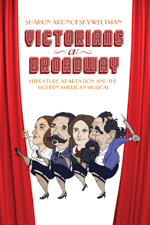Sharon Aronofsky Weltman, whose book VICTORIANS ON BROADWAY: Literature, Adaptation, and the Modern American Musical was published this July, writes about what the hit Hamilton shares with the classic The King and I. Read on below, and watch a trailer for VICTORIANS ON BROADWAY above.
What does the hit Hamilton share with the classic The King and I, besides enthusiastic applause—and even hugs to the actors—from Michelle Obama?
Both won Tony Awards, adoring audiences, and enormous profits. Both adapt nation-changing historical events, reshaping the past to critique the present. Both got clobbered for historical inaccuracies and for optimistically progressive positions on race that angered viewers from both the left and right.
Some reviewers of the Hamilton movie streaming on Disney+ say it subjugates minorities by having them play enslavers and oppressors. Others criticize factual omissions: the real-life founders were even more blemished than the characters portrayed on stage, where—despite Black actors in leading roles—almost no Black characters appear. Still others hold that Hamilton (filmed on Broadway in 2016) exhibits the naïve optimism of the Obama years, muting its power now. But its wildly popular reception demonstrates its undiminished impact, and most critics (and viewers) champion the show’s cross-race casting as seizing control of the national narrative for the widest spectrum of Americans. Last year, Kamala Harris regularly played “My Shot” at her rallies.
Almost seventy years earlier in 1951, Rodgers and Hammerstein’s The King and I (see the 2015 Lincoln Center revival on PBS) also provoked debate about its portrayal of slavery, race, and history. Banned in Thailand for its faulty depiction of a revered king, it also blends fact and fiction, inventing a near-romance between King Mongkut and Anna Leonowens and eliding the fact that the king’s wives, portrayed as slaves by the musical, were also slave-owners. The London opening in 2018 prompted some reviewers to ask outright if The King and I were Orientalist and racist.
Yet Hammerstein’s racial justice bona fides are strong. In 1954, he served the NAACP as national vice-president. He wrote the book and lyrics for Show Boat, which in 1927 for the first time fully integrated Black and White performers within a Broadway musical’s plot and condemned miscegenation laws, still commonplace at the time. Brown v. Board of Education was first filed in 1951, the year The King and I premiered; Rodgers and Hammerstein were ahead of the social justice curve, demanding and getting desegregated seating in theaters mounting their shows.
The King and I addresses American civil rights most directly in depicting the enslavement of the character Tuptim (a gift from the king of Burma to King Mongkut) and her rewriting of the 1857 novel Uncle Tom’s Cabin as a narrated ballet called “The Small House of Uncle Thomas.” This anti-slavery play-within-a-play aims to convince the king to release Tuptim to marry the man she loves. For 1951 audiences, the ballet responded simultaneously to contemporary American agitation for racial equity and to prior adaptations of Uncle Tom’s Cabin. The novel sparked a long and schizophrenic stage history of both abolitionist melodrama that helped to end slavery and blackface minstrelsy that perpetuated damaging, racist stereotypes. So how could the choreographer Jerome Robbins successfully appropriate Uncle Tom’s Cabin, restoring its anti-slavery roots and using it to combat racism in 1951?
In this ballet, dancer-actors of any race (every race, when including global performances) perform Thai court dancers in 1862, who in turn perform fictional African American slaves imagined by a White woman, Harriet Beecher Stowe. The performers wear whiteface (typical of Japanese classical drama) for portraying both Black and White characters. A few wear large masks, traditional in Thai dance-drama. These layers upon layers of identity performance help disentangle the ballet from earlier racist versions of Uncle Tom’s Cabin. They allow the musical its double focus on nineteenth-century slavery and contemporary agitation for civil rights while forecasting our current grasp of race—brilliantly expressed in Hamilton—as fluid, constructed, or performed.
Simply bringing people together to rally in groups conveys meaning beyond the words anyone says, as social theorist Judith Butler explains about crowds such as #BlackLivesMatter assembling for political protest. But the mere act of gathering inside theaters or on stages also means something. Rodgers and Hammerstein’s insistence on desegregated casts and audiences spoke volumes. In Hamilton, casting speaks loudly now.
The Hamilton troupe on Broadway spoke out literally when Brandon Victor Dixon, the actor then playing Aaron Burr, used the curtain call to urge Vice President-elect Mike Pence, attending the show, to protect our country’s diverse population. Still in costume but not in character, the multi-racial cast revealed explicitly the show’s visual and musical rhetoric: together (actors and audience), we are all still building our country, still establishing and claiming our foundationally equal rights.




